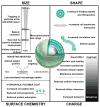Engineering nanomaterials to address cell-mediated inflammation in atherosclerosis
- PMID: 27135051
- PMCID: PMC4849406
- DOI: 10.1007/s40883-016-0012-9
Engineering nanomaterials to address cell-mediated inflammation in atherosclerosis
Abstract
Atherosclerosis is an inflammatory disorder with a pathophysiology driven by both innate and adaptive immunity and a primary cause of cardiovascular disease (CVD) worldwide. Vascular inflammation and accumulation of foam cells and their products induce maturation of atheromas, or plaques, which can rupture by metalloprotease action, leading to ischemic stroke or myocardial infarction. Diverse immune cell populations participate in all stages of plaque maturation, many of which directly influence plaque stability and rupture via inflammatory mechanisms. Current clinical treatments for atherosclerosis focus on lowering serum levels of low-density lipoprotein (LDL) using therapeutics such as statins, administration of antithrombotic drugs, and surgical intervention. Strategies that address cell-mediated inflammation are lacking, and consequently have recently become an area of considerable research focus. Nanomaterials have emerged as highly advantageous tools for these studies, as they can be engineered to target specific inflammatory cell populations, deliver therapeutics of wide-ranging solubilities and enhance analytical methods that include imaging and proteomics. Furthermore, the highly phagocytic nature of antigen presenting cells (APCs), a diverse cell population central to the initiation of immune responses and inflammation, make them particularly amenable to targeting and modulation by nanoscale particulates. Nanomaterials have therefore become essential components of vaccine formulations and treatments for inflammation-driven pathologies like autoimmunity, and present novel opportunities for immunotherapeutic treatments of CVD. Here, we review recent progress in the design and use of nanomaterials for therapeutic assessment and treatment of atherosclerosis. We will focus on promising new approaches that utilize nanomaterials for cell-specific imaging, gene therapy and immunomodulation.
Figures


References
-
- Heidenreich PA, Trogdon JG, Khavjou OA, Butler J, Dracup K, Ezekowitz MD, et al. Forecasting the future of cardiovascular disease in the United States: a policy statement from the American Heart Association. Circulation. 2011;123:933–44. - PubMed
-
- Keys A, Kimura N, Kusukawa A, Bronte-Stewart B, Larsen N, Keys MH. Lessons from serum cholesterol studies in Japan, Hawaii and Los Angeles. Annals of internal medicine. 1958;48:83–94. - PubMed
-
- Keys A. Wine, garlic, and CHD in seven countries. Lancet. 1980;1:145–6. - PubMed
-
- Cohen JC, Boerwinkle E, Mosley TH, Jr, Hobbs HH. Sequence variations in PCSK9, low LDL, and protection against coronary heart disease. The New England journal of medicine. 2006;354:1264–72. - PubMed
Grants and funding
LinkOut - more resources
Full Text Sources
Other Literature Sources
Miscellaneous
